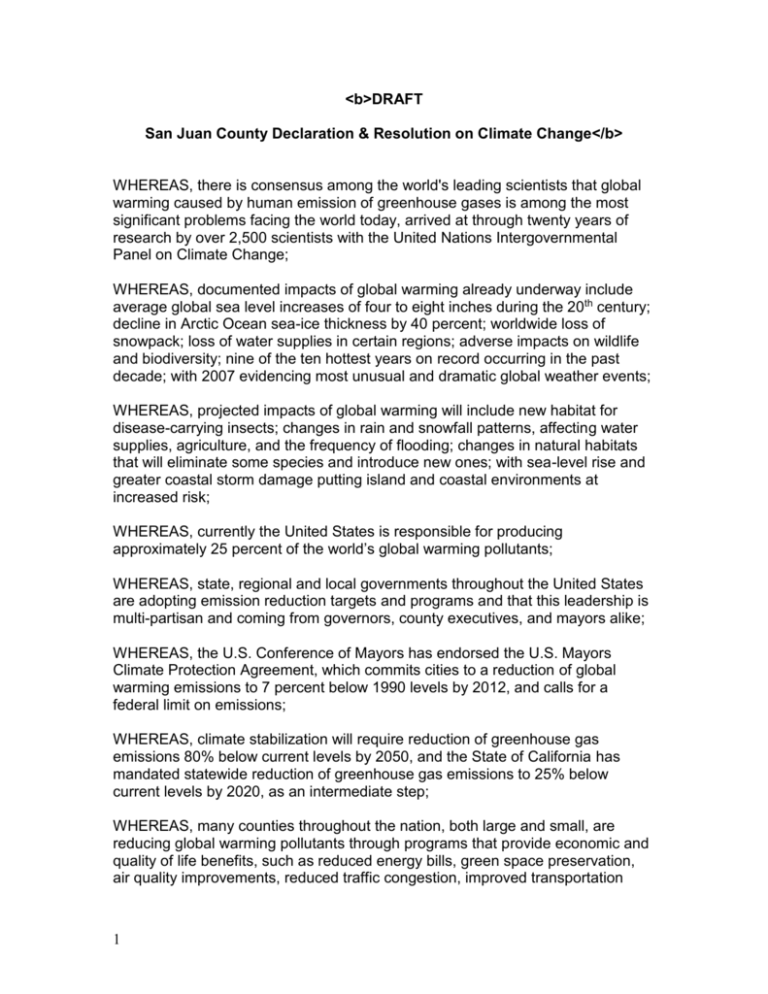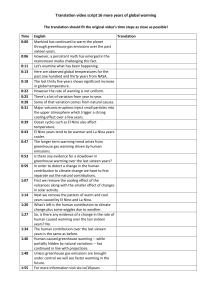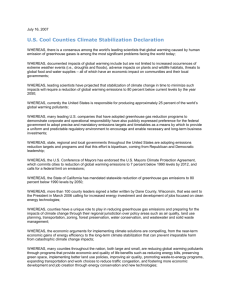downloaded here - Island Guardian
advertisement

<b>DRAFT San Juan County Declaration & Resolution on Climate Change</b> WHEREAS, there is consensus among the world's leading scientists that global warming caused by human emission of greenhouse gases is among the most significant problems facing the world today, arrived at through twenty years of research by over 2,500 scientists with the United Nations Intergovernmental Panel on Climate Change; WHEREAS, documented impacts of global warming already underway include average global sea level increases of four to eight inches during the 20th century; decline in Arctic Ocean sea-ice thickness by 40 percent; worldwide loss of snowpack; loss of water supplies in certain regions; adverse impacts on wildlife and biodiversity; nine of the ten hottest years on record occurring in the past decade; with 2007 evidencing most unusual and dramatic global weather events; WHEREAS, projected impacts of global warming will include new habitat for disease-carrying insects; changes in rain and snowfall patterns, affecting water supplies, agriculture, and the frequency of flooding; changes in natural habitats that will eliminate some species and introduce new ones; with sea-level rise and greater coastal storm damage putting island and coastal environments at increased risk; WHEREAS, currently the United States is responsible for producing approximately 25 percent of the world’s global warming pollutants; WHEREAS, state, regional and local governments throughout the United States are adopting emission reduction targets and programs and that this leadership is multi-partisan and coming from governors, county executives, and mayors alike; WHEREAS, the U.S. Conference of Mayors has endorsed the U.S. Mayors Climate Protection Agreement, which commits cities to a reduction of global warming emissions to 7 percent below 1990 levels by 2012, and calls for a federal limit on emissions; WHEREAS, climate stabilization will require reduction of greenhouse gas emissions 80% below current levels by 2050, and the State of California has mandated statewide reduction of greenhouse gas emissions to 25% below current levels by 2020, as an intermediate step; WHEREAS, many counties throughout the nation, both large and small, are reducing global warming pollutants through programs that provide economic and quality of life benefits, such as reduced energy bills, green space preservation, air quality improvements, reduced traffic congestion, improved transportation 1 choices, and economic development and job creation through energy conservation and new energy technologies; WHEREAS, a substantial portion of greenhouse gas emissions is caused by cars, trucks, planes, and ships; and in homes and offices, through inefficient use of heating, cooling, lighting and appliances, and insufficient recycling and reuse of materials; <b>NOW, THEREFORE IT BE DECLARED AND RESOLVED</b> that, The San Juan County Council, recognizing the critical nature of global warming and climate change, and cognizant of the actions being taken by local, state, and federal governments and other organizations around the globe, pledges to take immediate steps for climate change stabilization and strongly encourages San Juan County residents and businesses to reduce their carbon footprints, by making the following commitments: The San Juan County Council will serve as a model for the community by taking the following actions: 1. Switch to compact fluorescent, full spectrum compact fluorescent, and LED light bulbs in county government offices; 2. Instruct county staff to turn off all lights, computers, heating and air conditioning when not in use; 3. Reduce air travel for county business trips; 4. Continue to make composting bins available to county residents at wholesale prices; 5. Set up a county web site on climate change that allows input and exchange of people’s ideas on reducing greenhouse gas emissions and serves as an information resource; 6. Conform to the U.S. Green Building Council’s Leadership in Energy and Environmental Design (LEED) certification in all future county government buildings/remodels; 7. Set up a citizens’ action work group under the Smart Growth initiative umbrella to address global warming solutions; 8. Use biodiesel in county government diesel vehicles, as it becomes practical, with the goal of using B20 biodiesel in all county diesel vehicles by 2010; 2 9. Begin the switch to hybrid vehicles, when appropriate, in new county fleet purchases and continue the transition to more fuel efficient county vehicles; 10. Provide more trails and bikeways for walking and biking--provide more bicycle parking throughout the county--more striped bike lanes--improve and expand pedestrian crossings--keep up with road repair; 11. Investigate and promote the use of alternative energy sources, e.g., wind and solar power; 12. Start a bikeloaner program for citizens and ask county departments to use bikes where possible, e.g., Sheriff's deputies patrolling Friday Harbor, some Public Works staff, employees who can bike between home and work; 13. Adopt a green building code, with incentives, for San Juan County; 14. Require all county departments to buy recycled products, when possible, including paper products that use at least 30% recycled content; 15. Plant more trees throughout San Juan County, particularly where they can provide shading and canopies-- and thus sequester carbon dioxide; 16. Encourage and support mini-bus and mini-van service throughout San Juan County, as well as the use of the sjRIDESHARE program; 17. Create an inventory of both county government operational and county geographical greenhouse gas emissions. Set a target of greenhouse gas emissions reductions to a range of 80% below current levels by 2050 (“Climate Stabilization”), and encourage other counties to execute the same or undertake a similar commitment; 18. Reduce San Juan County government contractual arrangements, whenever possible, with entities know to be major emitters of greenhouse gases; 19. Require solid waste facilities countywide to handle and provide for full recycling, composting, and reuse centers; 3 20. Institute mandatory recycling of all recyclable products in all county buildings and facilities; 21. Negotiate with San Juan Sanitation the ability to have countywide curbside recycling; 22. Perform a comparative study of vehicle emissions, comparing the emissions of trips to solid waste facilities by the public to the emissions of garbage trucks doing curb-side pick-up of solid waste; 23. Investigate a county vehicle emission inspections program similar to the programs of other Washington counties; 24. Purchase non-styrofoam containers for all county facilities; 25. Do everything possible to reduce commerce-related longdistance travel, e.g., by encouraging all county departments to buy as locally as possible --food products, merchandise, etc.; 26. Work with Washington State Ferries to encourage increased pedestrian and bicycle traffic on ferries coming to the islands, and ask the San Juan Islands Visitors Bureau to encourage tourists to reduce their use of cars in the San Juan Islands. Here are ten actions that San Juan County residents and businesses can take: 1. Know your carbon footprint in order to understand your energy use habits - use the Bonneville Environmental Foundation’s “carbon calculator” that is tailored to the Pacific Northwest (www.b-e-f.org); 2. Reduce energy use by switching to compact fluorescent, full spectrum compact fluorescent, and LED light bulbs; 3. Reduce energy use by driving less -- walk, bike, carpool, rideshare, use hybrid and electric vehicles, and let children ride buses to school; 4. Reduce energy use by buying local produce/food products and other market products, avoiding products shipped long distances, and use canvas bags for shopping; 5. Reduce energy use by turning off all electrical equipment and lights when not in use; 4 6. Reduce energy use by improving home energy efficiency (ask OPALCO for a home energy audit) and buying EnergyStar appliances; 7. Reduce energy use by turning down water heater thermostats to 120 degrees; 8. Recycle all newsprint, cardboard, glass, metal, and plastic; 9. Compost food products and yard waste; 10. Plant more trees and shrubs to absorb carbon dioxide. August 23, 2007 5







